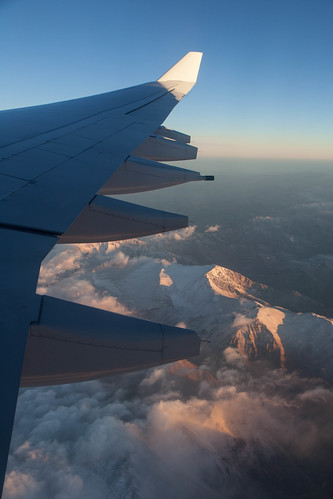Valparaiso bus station, 1.30pm. A taxi tout grabs us with his English and ushers us to a waiting minivan. Ten minutes later we are standing with our bags, alone and shivering in the fog on the street outside a locked up hostel.
The hostel turns out dingy and scruffy. Hmm, no matter, we've paid already and it's only two nights... we'll be fine. Well no point hanging around here, let's go see the city! We saunter down the road until it peters out into a piss-stained staircase peppered with mangy dogs. The city that presents itself to us as the foot of the stairs is no better. Tatty and scruffy we start to wonder what makes people visit this UNESCO world heritage site.
"Hey you want eat?", we avoid the restaurant touts and dive into a veggie cafe offering empenadas vegetarianas. Finally a place of tranquility we tiptoe around an argument with one another wondering why we've found ourselves here and end up burying our heads in books.
By evening, heads spinning with facts maritime garnered from the museum we ride the funicular and discover Cerro Conception. Ok, I'm beginning to get it.
A morning visit to Neruda's house at Ferrari 692, empanadas famosas and now holed up in a cafe, a glass of red, pianist playing and sorting pictures and thoughts. I'll come back to Valparaiso.
Sunday, 27 April 2014
Saturday, 26 April 2014
Days 11 - 14: Easter Island
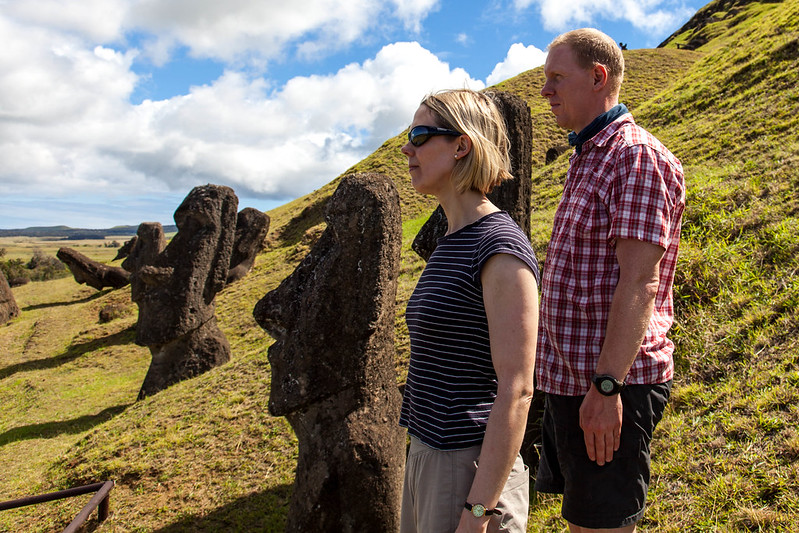 Flying for five hours off the coast of Chile and expecting to find an airstrip somehow felt improbable, as we boarded the plane for Easter Island on Monday morning. Finding it by canoe from an unknown part of Polynesia seems even less likely. Given that Easter Island is little more than twenty kilometres long and located over a thousand miles from Chile (to the East) and Pitcairn Island (to the West), the words 'needle in a haystack' spring to mind, but somehow a Polynesian canoe managed to thread it around fifteen hundred years ago. And they turned it into quite some needle!
Flying for five hours off the coast of Chile and expecting to find an airstrip somehow felt improbable, as we boarded the plane for Easter Island on Monday morning. Finding it by canoe from an unknown part of Polynesia seems even less likely. Given that Easter Island is little more than twenty kilometres long and located over a thousand miles from Chile (to the East) and Pitcairn Island (to the West), the words 'needle in a haystack' spring to mind, but somehow a Polynesian canoe managed to thread it around fifteen hundred years ago. And they turned it into quite some needle! |
| Moai near Hanga Roa |
First stop was a set of Moai just north of Hanga Roa (Easter Island's only town). The Moai are the iconic stone figures dotted all around the island, representing the islanders' ancestors and serving as objects of worship, to protect them from harm. Like all Moai, they looked landwards, across the island, with their weathered faces, vacant eyes, and resilient majesty. We snapped our first few dozen photographs, not quite realising how many zillion more would be needed over the next few days. (Charge up those batteries; they'll be needed!)
But first, it was time to become vocal fans of the local tipple, Pisco Sour (add mango for the best effect, yuuumm) and sit by the ocean in our t-shirts eating amazing sea food. Who needs to climb mountains? This is the life!
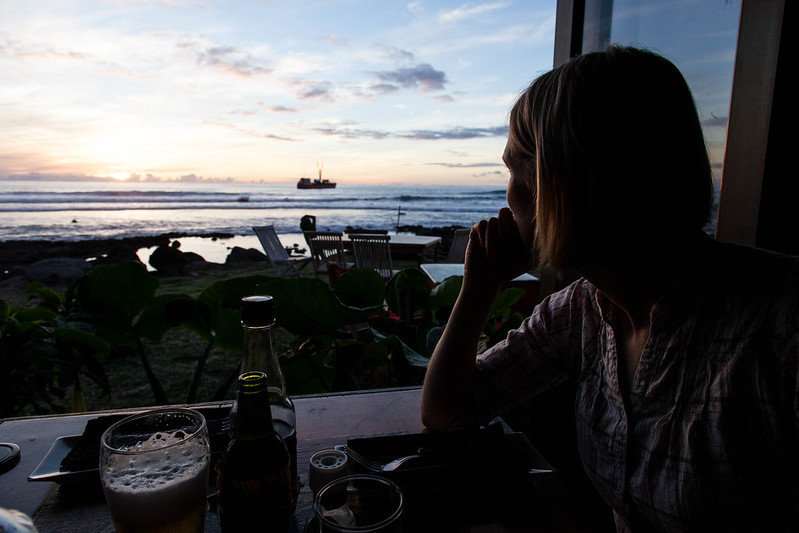 |
| Easter Island sunset |
The next day we took a tour of many of the main Moai sites on the island. The first couple featured the Moai statues lying broken, face down on the dark volcanic rocks of the shore. Why? Apparently, as natural resources declined, including agricultural products and timber for building canoes, the islanders decided that the gods weren't doing a great job of protecting them and toppled them. Captain Cook reported as much when he visited the island, although he didn't make a long stop here. Finding sources for information about the culture of the island is incredibly difficult, to say we are dealing with events only a few hundred years ago. Take it as read that 'they think', 'apparently', 'so far as we know', 'this is how one theory goes' etc. etc. accompany most sentences here.
 |
| Toppled Moai |
Later in the morning we visited the inland quarry where the statues were carved out of the rock. I found it the most impressive of all the sites we visited but archeological and historical problems came even thicker and faster here than elsewhere. Why were there several hundred Moai in production in the quarry at the time when this form of worship ceased, given that only a couple of hundred finished Moai had been installed in the preceding millennium? And how did Moia over twenty metres high make it from the quarry down to the shore without the help of the mighty petrol engine? Anyone with a passion for turning over theories of transportation (ranging from wooden rollers to UFOs) should make their way here sharpish!
 |
| Ranu Raraku: birthplace of the Moai |
As much as anything, we loved the range of styles of the different Moai; many rooted in the quarry had thinner figures with sharper facial features than their more rounded counterparts on the coast. Such characteristics must of course be photographed! Time to reach for the cameras. And again. And just one more. Got it? Yes. Oh, change of light. Better take it again ...
 |
| Tongariki (from Ranu Raraku) |
With groaning memory cards, we made it back down to the coast to a couple of sites where once-toppled Moai had been re-erected to stand overlooking the bay in their former glory. One exception was the figure washed about fifty metres inland by a tsunami. There are tsunami warning signs dotted around the island directing you where to go if the sea decides it's time for an almighty clean-out (upwards, towards higher ground, being the general gist). Guy decided at this point to start calculating the probability of a tsunami taking place during our visit until I pointed out that we will be spending the next three months travelling along a massive tectonic plate boundary and this probably isn't the moment to get nervous about it.
 |
| Just another Rapa Nui sunset |
At the last site of the day, the Moai had to compete with a few other distractions: namely, a sandy beach and a beer tent. We nonetheless paid them homage first, but our cameras got off relatively lightly before it was bikini time and then beer time. Take ten on the words 'this is the life'. The evening brought take eleven (Pisco Sour), take twelve (an amazing fish dinner courtesy of Te Moana), take thirteen (watching surfers at sunset), take fourteen (a nice Chilean white) and so on and so on. (Trying to make the readers jealous? Me? Never.)
Daylight hours seem rather strangely timed here; the sun rises around 8:30am and sets about twelve hours later. Breakfasts are generally late and leisurely as a result, but on our third day we got up at the ungodly hour of 7am to catch sunrise at Tongariki - one of the most impressive sites we had visited the day before. We hitched a lift with our next door neighbours at the hotel and stepped onto the deserted beach around 7:45. By about 7:50, we discovered that several hundred other tourists had had the same idea. With our mountaineering hats on, we've got used to secluded places and become proprietorial about our vistas, but over the last couple of days we've had to adjust to the idea that you can't have such impressive sights to yourself! When the sun hit the sides of the row of figures, it was of course worth both the early wake-up call and the crowd.
Next stop was the top of one of the volcanoes, which has a huge crater lake with a lip opening onto the sea. On its upper slopes there is a village that was inhabited for just a few weeks a year in the final few centuries of undisturbed Easter Island life, before us brutal westerners got our hands on the place. By the time the village was built, the Gods had had their day and this village was used for the annual ceremony associated with the Bird Man cult; the young and strong (and male, of course) raced down the volcano, swam to an island and collected the first bird eggs of the season, in a bid to give their tribe the rule of the island for a year. In the rain, and without a guide, we probably got less out of this site than we should have done but we spent some time in the evening reading up its history. We also learned more about the later (grimmer) centuries of island life after western ships suddenly emerged on the horizon after a millennium of isolation. (Capturing the locals to serve as slaves, carrying them to Peru, introducing smallpox - that kind of spread of 'civilisation' - is, unfortunately, all part of the tale and makes for harrowing reading.)
Our time on Easter Island was running out fast at this point so we went for a final swim, a final beer on the beach (I plead innocent of all beer-drinking of course; it's disgusting stuff!) and a final Pisco-fish-wine-sunset combo. Guy somehow managed to convince me that the toilets in this particular restaurant were so beautifully decorated with flowers that I simply couldn't miss them (how did I fall for this?) and, in my absence, he asked the waitress to bring me a birthday pudding with candles. I don't think I've had as good a round of birthday applause in a restaurant since I was a student! Well, if you have to get a year older, Easter Island's a pretty good place to do it.
After a final breakfast of mango, banana, eggs and pancakes, and a quick trip to the museum, it was time for reality to hit and Santiago to appear again below the wings of LAN airlines. Big sigh, accompanied by culture shock extraordinaire. Easter Island may be a long way to travel for a few days but it's amazing; go there.
Tuesday, 22 April 2014
Sunday, 20 April 2014
Day 9 - More Santiago
A functional day on Good Friday catching up on washing and eating.
Yesterday we managed to do quite a bit more starting off with a trip to the Chilean Natural History Museum. Arranged like a walk from the north to the south of Chile it mostly made us realise how much there is to see here and how we need to get out of Santiago (don't worry, we're gone tomorrow!). Also of note, a reproduction of the Inca mummy from the top of the mountain we failed to climb last week. Can't believe the Inca's managed it without Goretex and down jackets!
A fish lunch at the central market (enjoyed the grilled razor clams with parmesan) and finally a visit to the Pre-Colombian Arts museum. The quipus were mesmerising: an amazing form of information storage using string.
 |
| Central Market |
 |
| Quipu |
Friday, 18 April 2014
Days 1 - 7: How kind of the mountain gods!
It's the end of week one already so it's time for the story so far - a tale of cold toes, cold nose, fine views (vulnerable to the power of sudden vanishing spells) and sunny mountain ridges. So ...
Beginning with a middle class crisis (guaranteed not to last more than two sentences), we arrived in Santiago last Friday to hear the breaking news that Iberia airlines had been awarded a Michelin star for their onboard catering. Commentators believe this is largely due to the quality of their vegetarian offer (a box of lettuce for dinner followed by a box of lettuce for breakfast, in case you were wondering). Quote Guy to the air hostess: I ordered a meal for a vegetarian not a rabbit. Fortunately, we fared better in steak-loving Santiago where we stocked up on snacks in a lovely vegetarian cafe - then stocked up on maps in the Government map shop. For those trekking in Chile, it's located just south west of the centre, near Los Heroes metro, and sells 1:50,000 for much of the country.
Even though it's a less-heralded city than Buenos Aires, we're enjoying staying in Santiago. As mountain-lovers, this may be because there are hills and viewpoints all around. We headed over to San Cristobal, which stands about 400m above the city, for a good view of the high-rises (and low-rises), parks, motorways and all the rest of the surprisingly-alluring urban shebang encircled by mountains. At the bottom of the climb we found ourselves behind a large and vocal procession. A political protest? No. There are only eight days to go until Easter Sunday and that God chap seems to be causing a rumpus as usual. But we soon left everyone behind and climbed the steep path to the summit where there is a large white statue of Mary on the hillside and an array of 'silencio' signs, made more amusing by the jubilant (ie. noisy) religious celebrations taking place just below. There was a great view of the city though and we particularly noticed the snowy tip of a distant mountain, just emerging through the urban haze: Cerro Del Plomo. This was our mountain.
Day 3 (Sunday April 2014) we set off to climb it, carrying our tent and stove, six days of food, down jackets and sleeping bags. We drove up to the Valle Nevado ski resort at 3,500m and spent the first hour of the day trying to drop a friendly canine who would absolutely not be getting a share of our rations for the duration of the trip, which was difficult as the dog lacked a heavy rucksack and was clearly fitter than us. Once we'd finally made it clear that we weren't human beings of the dog-loving (or even tolerating) variety, we continued on our way across a couple of low ridges before dropping down into a river valley to camp.
Guy was suitably ecstatic to find a low wall ready-assembled to shield his 'kitchen' and settled to his role as chef of a true pasta and river water feast. The night was surprisingly cold and, in the morning, the water that I fetched from the river froze in the pan before it could reach the stove (about 20m away). A sign of things to come? Nonetheless, we set out on an acclimatisation trek up onto the ridge above, where we sat reading in the sunshine for a few hours. Bliss. Who needs an office job?
The next day we de-camped and trekked further up the valley until we reached a camping spot at 4,400m. Despite the previous day's acclimatisation trek, we didn't want to go any higher and, in any case, there was no need. The summit was only 1,000m above us and we'd climbed the same height earlier today carrying full camping gear in less than 4 hours. Everything was set. The sun was shining and had been for the last four days. The air was still. The peak looked serene. The path up to it was clearly visible, and we had our crampons and ice axes ready for the short glaciated section. We could almost reach out and touch the summit from where we sat. Time for an early night before a (surely successful?) summit day.
But no. As we were getting ready for bed, the wind whipped up and proceeded to shake our tent violently all night. Having pitched in the calm, we hadn't given much thought to the prevailing wind direction and so it was blowing full on to the front door of our canvas mansion - gradually blowing the zips open at regular intervals so we had to get up and close them. Never mind - we had loaded the guy ropes with rocks and when the alarm beeped we found, mercifully, that we were not yet airborne. Plenty of other things were airborne, however. Lots of clouds. Waves of spindrift. But no sun. And definitely no warmth.
With the tent swaying like a sick animal, we decided to descend a few hundred metres to a primitive shelter and wait until the following day - we'd brought an extra day's rations for exactly this scenario. So we climbed back down the path and spent the rest of the morning melting snow to make porridge and tea, as H2O no longer existed in liquid form at this altitude. It's just possible we'd made Captain Scott's error and failed to bring enough fuel for lots of snow melting. Well, we weren't the only people to be in trouble in this shelter. One bit of graffitti on the wall went along the following lines: 'today we're eating our last pack of soup after being here for five days. One of my friends has frost bite in two of his fingers. The other throws up everything he eats. I'm going to go and get help ...'. Perhaps we weren't doing so badly after all!
A guide and his client arrived in the afternoon and we were happy to hear human voices for the first time since we started the trek. The next morning they set out before us. We awoke to find that the thermometer read -5 degrees inside the tent; goodness knows what the temperature was like outside in the wind chill. And by now we had no desire to find out what the temperature was like on the summit - no-more-fingers-no-more-toes-lets-just-bloomin-get-outta-here temperature, most likely. Just as we finished packing up our tent for the retreat, we heard the guide returning, having been turned back by the wind. Yes, heading down was the right decision. The one consolation prize was the discovery of a bottle of red Chilean wine, unopened, on the descent route; how kind of the mountain gods to give us something to drown our disappointment in!
And so, yesterday afternoon, we found ourselves back down at 2,500m (where it was still cold enough to need a down jacket if you stopped for long) in the village of Farellones. We checked into a hotel, revelled in the existence of hot water, groaned at another meal of spaghetti and tomato sauce, and drooled over the view: yellowing autumn trees fringing a cloud inversion that drowned the city of Santiago in haze. And we drank the red wine. Well, there's a surprise!
Now we're back in Santiago, Del Plomo already feels distant and we're busy plotting the next adventure. It may be Del Plomo 1, Susan and Guy 0, but there are other ways to spin it. Susan and Guy 1, frost bite 0, for example. Susan and Guy 1, getting-blown-off-a-mountain 0. Yep, I'll go with either of those. There are plenty more mountains to climb where Del Plomo came from and perhaps we'll have better luck further north where it's warmer. We have our eyes on a few volcanoes in the Atacama. In the meantime, it's Easter, so it would be wrong not to go to Easter Island, wouldn't it? We'll post another update from there.
More pics from Days 1-7:
Beginning with a middle class crisis (guaranteed not to last more than two sentences), we arrived in Santiago last Friday to hear the breaking news that Iberia airlines had been awarded a Michelin star for their onboard catering. Commentators believe this is largely due to the quality of their vegetarian offer (a box of lettuce for dinner followed by a box of lettuce for breakfast, in case you were wondering). Quote Guy to the air hostess: I ordered a meal for a vegetarian not a rabbit. Fortunately, we fared better in steak-loving Santiago where we stocked up on snacks in a lovely vegetarian cafe - then stocked up on maps in the Government map shop. For those trekking in Chile, it's located just south west of the centre, near Los Heroes metro, and sells 1:50,000 for much of the country.
Even though it's a less-heralded city than Buenos Aires, we're enjoying staying in Santiago. As mountain-lovers, this may be because there are hills and viewpoints all around. We headed over to San Cristobal, which stands about 400m above the city, for a good view of the high-rises (and low-rises), parks, motorways and all the rest of the surprisingly-alluring urban shebang encircled by mountains. At the bottom of the climb we found ourselves behind a large and vocal procession. A political protest? No. There are only eight days to go until Easter Sunday and that God chap seems to be causing a rumpus as usual. But we soon left everyone behind and climbed the steep path to the summit where there is a large white statue of Mary on the hillside and an array of 'silencio' signs, made more amusing by the jubilant (ie. noisy) religious celebrations taking place just below. There was a great view of the city though and we particularly noticed the snowy tip of a distant mountain, just emerging through the urban haze: Cerro Del Plomo. This was our mountain.
 |
| Let's climb that one. |
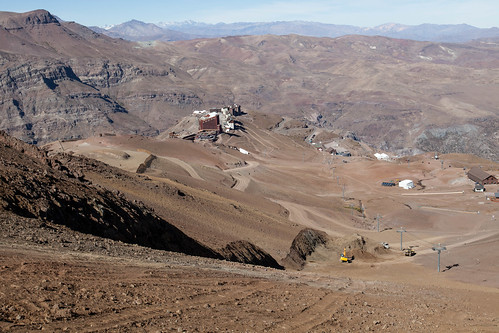 |
| Bloody dog still following us half way up a blue run. |
 |
| Me caveman, me make fire! |
The next day we de-camped and trekked further up the valley until we reached a camping spot at 4,400m. Despite the previous day's acclimatisation trek, we didn't want to go any higher and, in any case, there was no need. The summit was only 1,000m above us and we'd climbed the same height earlier today carrying full camping gear in less than 4 hours. Everything was set. The sun was shining and had been for the last four days. The air was still. The peak looked serene. The path up to it was clearly visible, and we had our crampons and ice axes ready for the short glaciated section. We could almost reach out and touch the summit from where we sat. Time for an early night before a (surely successful?) summit day.
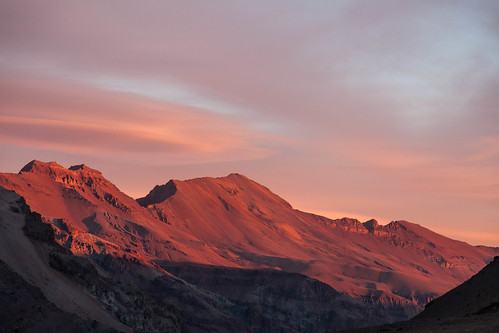 |
| Red sky at night... Shepherd's Delight! |
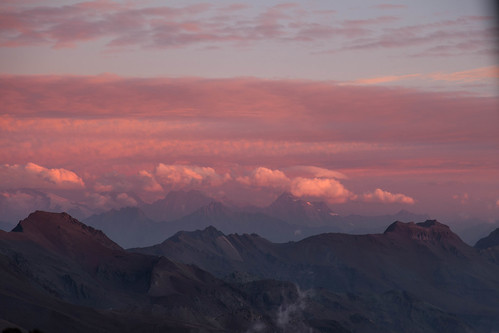 |
| Red sky in the morning... Shepherd's, beware a bloody nasty cold day! |
 |
| Unknown to us at this point, this shelter (and it's accompanying mouse) would be our home for 24 hours after we retreat back to it the next day. |
And so, yesterday afternoon, we found ourselves back down at 2,500m (where it was still cold enough to need a down jacket if you stopped for long) in the village of Farellones. We checked into a hotel, revelled in the existence of hot water, groaned at another meal of spaghetti and tomato sauce, and drooled over the view: yellowing autumn trees fringing a cloud inversion that drowned the city of Santiago in haze. And we drank the red wine. Well, there's a surprise!
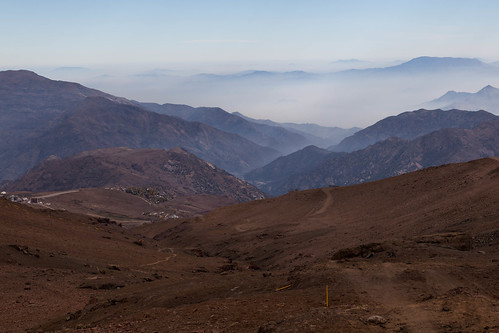 |
| That's Santiago down there in all the smog. Actually, we found out afterwards that there had been a large fire in the nearby city of Valparaiso. |
More pics from Days 1-7:
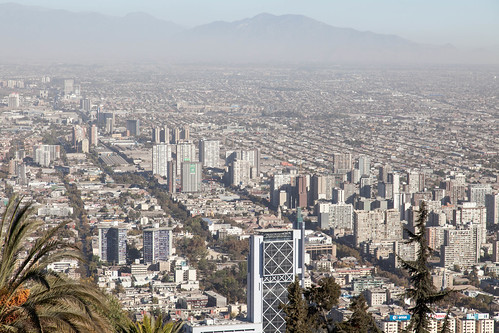 |
| Santiago sprawl |
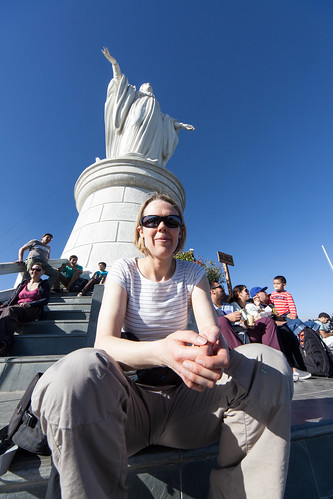 |
| Madonna... and child: "Can I have an ice cream?" |
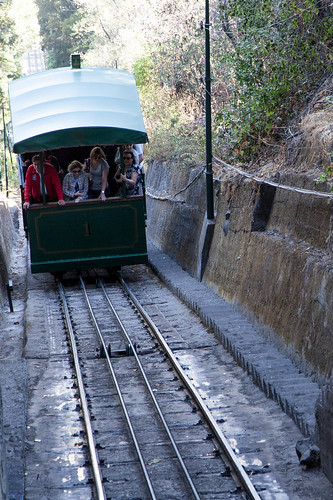 |
| Ahhhh... a train, that's better! |
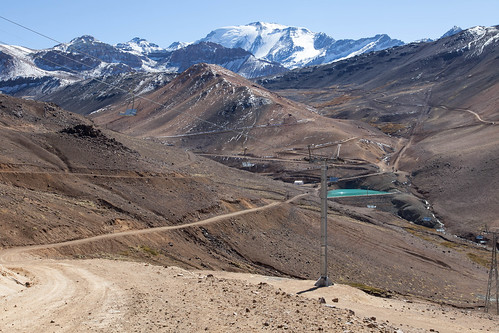 |
| Cerro del Plomo from the top of the first ridge. |
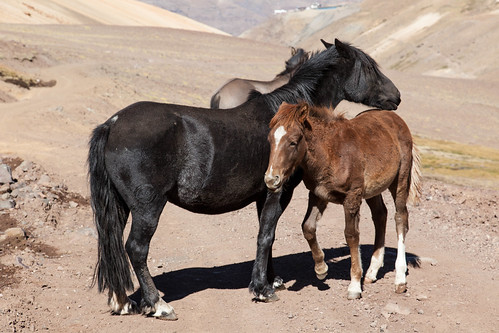 |
| OMG!!!!! PONIES!!!!! |
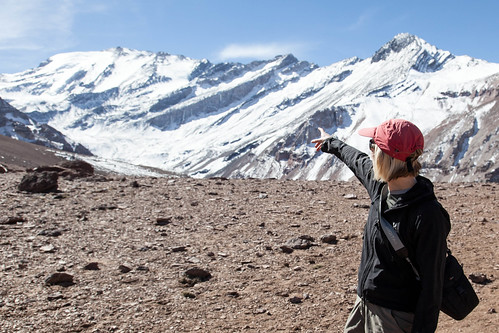 |
| That one. |
 |
| On arrival at our first camp we found this chap overturning rocks with his talons looking for food. |
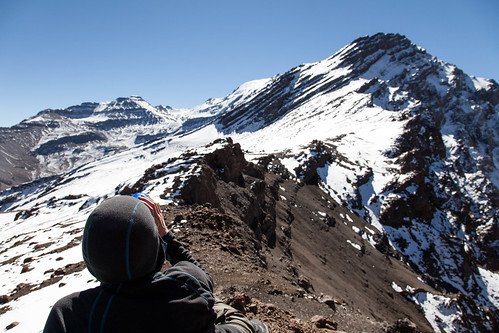 |
| Calm, serene weather: "I think this one's in the bag, Guy!" |
 |
| Easy does it up to advanced base camp. Lovely weather innit? |
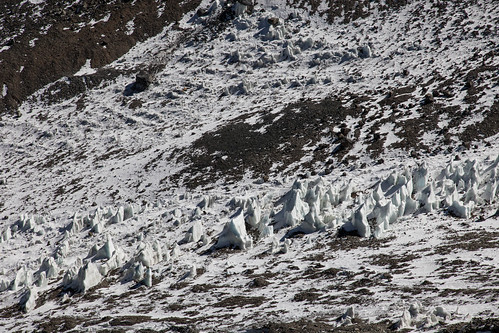 |
| Penitites on the Glaciar Esmerelda |
 |
| Waterfall with climbing potential. A rather fragile WI3? |
Thursday, 17 April 2014
Thursday, 10 April 2014
Homeless on The Strand
Bags packed, last minute shopping completed and almost all of my personal belongings either on my back, in storage or given away. Not even a set of keys in my pocket... How liberating!
Tuesday, 8 April 2014
Water Purification
I'm sitting at my parents house sorting through all the water purification tablets that we are taking with us. For some reason we've got 4 different types!
It's been quite hard to find a summary of how effective the different types of tablet are against the different types of nasties that inhabit the water sources that you are likely to want to drink from when out in the hills. First up, it's worth knowing what you are up against:
Here's a quick chart of how effective various methods of treatment are:
So, in conclusion, given that we don't want the weight/bulk of carrying a filter, the choice is Chlorine Dioxide tablets.
Hope they taste nice!
It's been quite hard to find a summary of how effective the different types of tablet are against the different types of nasties that inhabit the water sources that you are likely to want to drink from when out in the hills. First up, it's worth knowing what you are up against:
- Bacteria (we all know what these are)
- Viruses (ditto)
- Protozoans - micro organisms that are a bit bigger than bacteria but still single-celled. There are two types that will give you tummy trouble: Giardia and Cryptosporidium.
Here's a quick chart of how effective various methods of treatment are:
| Purification Type | Bacteria | Viruses | Protozoa: Giardia | Protozoa: Cryptosporidium |
| Chlorine/Iodine Tablets | HIGHLY EFFECTIVE | HIGHLY EFFECTIVE | LOW-MODERATE | NOT EFFECTIVE |
| Chlorine Dioxide Tablets | HIGHLY EFFECTIVE | HIGHLY EFFECTIVE | HIGHLY EFFECTIVE | LOW-MODERATE |
| Filtration with filter < 0.3 micron size | HIGHLY EFFECTIVE | NOT EFFECTIVE | HIGHLY EFFECTIVE | HIGHLY EFFECTIVE |
| Boiling | HIGHLY EFFECTIVE | HIGHLY EFFECTIVE | HIGHLY EFFECTIVE | HIGHLY EFFECTIVE |
So, in conclusion, given that we don't want the weight/bulk of carrying a filter, the choice is Chlorine Dioxide tablets.
Hope they taste nice!
Subscribe to:
Posts (Atom)







